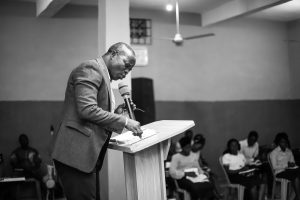Who trained leaders to plant congregations in the early church? That has been the subject of my past three blogposts. We first looked at a general introduction to leadership training in the book of Acts, followed by the early signs of leadership development in Acts, and then the church spreading through the church planting ministry of the saints scattered due to persecution. The present post will take a brief glance at training with Paul’s mission and his partners in ministry. My next post will offer concluding observations to leadership training in Acts.
Johannes Nissen identifies three categories of fellow-workers with Paul. (1) The most intimate circle included Barnabas, Silas, and Timothy. (2) Aquila, Priscilla, and Titus represented “independent co-workers.” (3) The last group, local church representatives, put workers at Paul’s disposal so that the churches partnered with him in church planting ministry.[1] While the first two categories figured most prominently in the NT, the last involved considerable numbers of workers.
Significantly, Paul’s ministry, as Nissen rightly explains, was not hurried proclamation to the nations. “His ministry also had a more pastoral aspect,” evident by his letters. He did not simply plant a church and move on to another; he sought to shepherd the new disciples in the faith.[2] Unlike the philosophers of his day that sought to change individuals, Paul sought to form communities of disciples who continued on in the faith—and that could only happen with sufficient leadership.[3] He placed priority, as evident from the Acts narrative and his epistles, on making sure that shepherding leaders continued to teach and train the churches in the faith (e.g. Acts 17:14–15; 18:24–28; 2 Tim 4:10–12; Titus 3:12–14). This post will look at leadership development in the intimate circle, independent co-workers, and local church representatives in Pauline ministry.
Intimate Circle
Silas, one of the “leading men among the brethren” in Jerusalem, had been deputed by the Jerusalem church to address the churches of Syria and Cilicia with the Jerusalem Council’s message (Acts 15:22–33). That the church in Jerusalem recognized his giftedness as a good representative of the faith indicates that Silas spent considerable time involved with that congregation. The “whole church,” along with the apostles and elders, chose him as a representative to the Gentile believers (Acts 15:22). The church had ample opportunity to attest to his character, servant-leadership, knowledge of Scripture, and preaching ability. They sent him on no small task! This observation assumes that Silas’s involvement in the Jerusalem church shaped and prepared him for future ministry to the point that his congregation happily commended him to this epochal ministry to the Gentile church. The opportunities granted earlier to Silas by the Jerusalem church gave them confidence to send him on this vital and sensitive mission of the early church, and later as Paul’s mission partner. The Jerusalem church’s leaders and congregation left its mark on his ministry.
Although still a young man, eighteen to twenty years old by various reckonings,[4] the evidence of Timothy’s call to ministry and gifts to serve, prompted the Lystran and Iconium elders to set him apart for gospel preaching and teaching (1 Tim 1:18; 4:14; 2 Tim 1:6–7).[5] Paul would later remind him of this sacred time that his church’s elders, presumably with the whole-hearted support of the congregation, set him apart for ministry. Significantly, his reputation went beyond his home church in Lystra to the Iconium church as well.[6] This suggests that Timothy had also engaged in some acts of ministry with the latter church so that they could readily affirm his gifts for ministry. It seems probable that he learned something of the ministry of elders by observing and receiving from those that Paul and Barnabas had appointed in his church (Acts 14:23). He had learned something of what it meant to model the Christian faith as he observed, and maybe served under, the elders in Lystra and Iconium. By listening to Paul and others ministering in Lystra, he had learned something about gospel conversations and proclamation.
Independent Co-Workers
Aquila and Priscilla[7] had significant ministry in Ephesus, where Paul left the couple after their time of service in Corinth (Acts 18:18–19). They left no gap in the work initiated by Paul in Ephesus, especially by their mentoring efforts with the eloquent Alexandrian believer Apollos (Acts 18:24–28). As they had done in Corinth, the couple opened their home to host a new church in Ephesus,[8] training disciples, such as Apollos, for fuller gospel ministries. Their leadership in preparing Apollos “for a vigorous and effective ministry in Corinth,” David Peterson commented, demonstrated the “interconnection and interdependence of churches in the apostolic period.”[9] Luke’s narrative during the missionary labors of Paul offers only a small window into the personalities engaged in church planting, as well as those training them. Yet one has no difficulty thinking that Aquila and Priscilla multiplied their discipling and mentoring efforts beyond Apollos, while serving in Corinth and Ephesus (Acts 18), then later back in Rome (Rom 16:3), and once again back in Ephesus (2 Tim 4:19). Paul knew them to be dependable, theologically astute, and winsome in relationships—just the right balance needed in training others to preach Christ, plant churches, and build up believers.[10]
Although Luke makes no reference to Titus, he was involved in Paul’s ministry recorded in Acts. Paul identifies him as a Greek (Gal 2:3) who accompanied the apostle and Barnabas on a special journey to Jerusalem (Gal 2:1–10). Assuming that Titus joined Paul and Barnabas on the Acts 11:27–30 famine-relief journey,[11] his association with Paul as a competent representative predated the first missionary journey, indicating him as an early part of the Antioch church who would have trained and prepared him for ministry.
Paul called Aquila, Priscilla, and Titus his “fellow workers” (Rom 16:3; 2 Cor 8:23), with Titus also called “my partner” among the Corinthian church. While traveling with Paul on occasions, most of their ministries came through assignment or pastoral opportunity. Those mentoring them in ministry laid groundwork for strong impact through them in the early church.
Local Church Representatives
Paul names upward of forty persons involved in sponsoring his missionary activities.[12] Many more—Jews, Gentiles, women, and slaves—accompanied him temporarily or permanently on his journeys, participating at various levels of mission work.[13] His practice of involving local church representatives implies an important ecclesiological note: mission work is teamwork.[14] Each disciple involved in proclaiming Christ, planting churches, and nurturing congregations used “their gifts to enrich the church in other places.”[15] Although often unnamed, the congregations of the first century sent their finest members to do kingdom work beyond their own communities, with many of the churches having done initial preparation for those they sent out to minister. Luke recognized Erastus who ministered with Timothy in Paul’s mission team (Acts 19:22), Gaius and Aristarchus as traveling companions from Macedonia (Acts 19:29), and Sopater of Berea, Aristarchus and Secundus of Thessalonica, and Tychichus and Trophimus of Asia (Acts 201–5). Their churches laid groundwork for their mission work.
While Paul notably mentored and continued training those partnering with him in ministry, what seems apparent by the observations made in Acts is that each local church had some part in preparing and sending out these first century Christian workers. That remains the pattern for every church engaged in the work of planting, shepherding, and revitalizing local churches.
Phil A. Newton






















